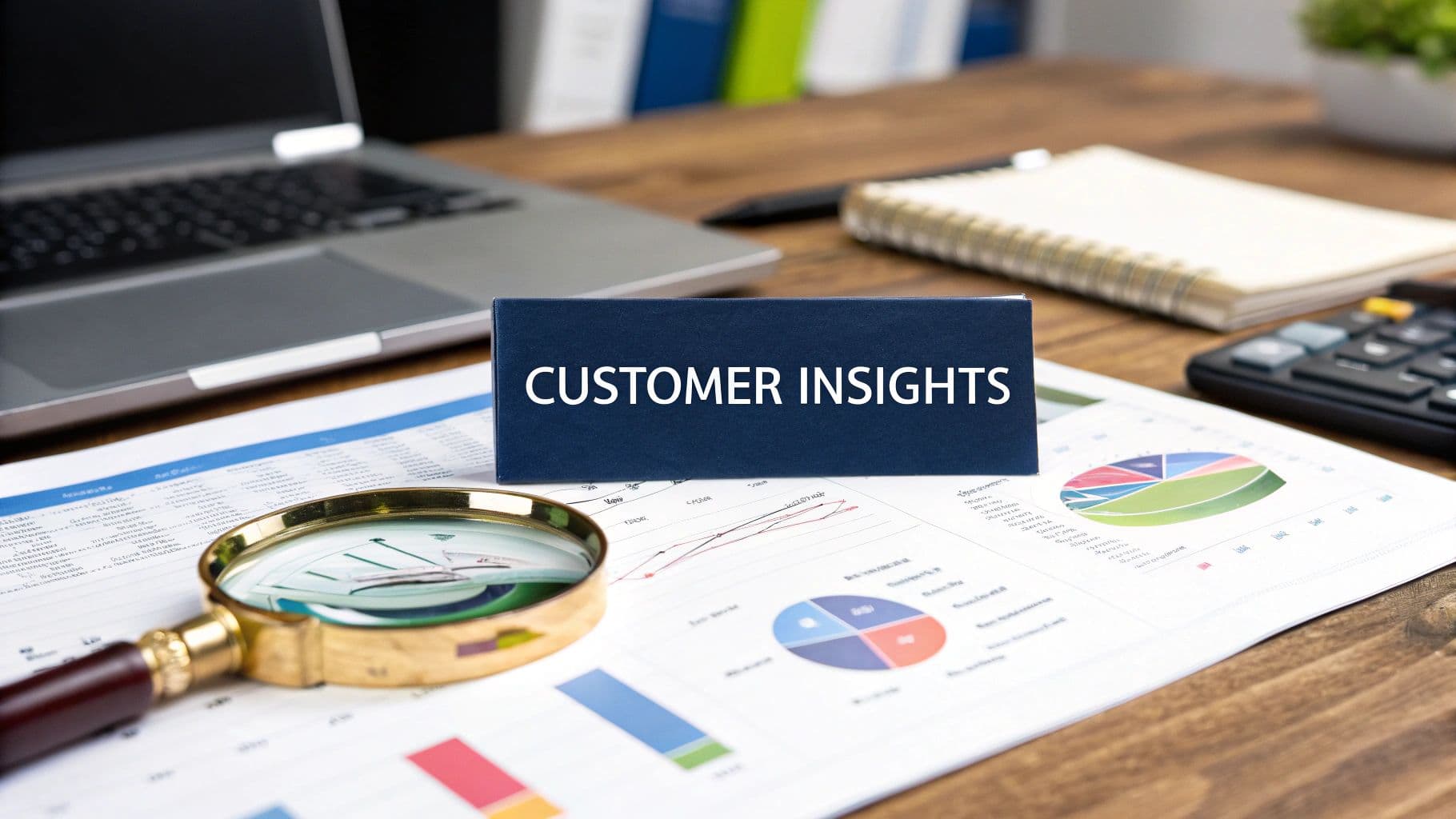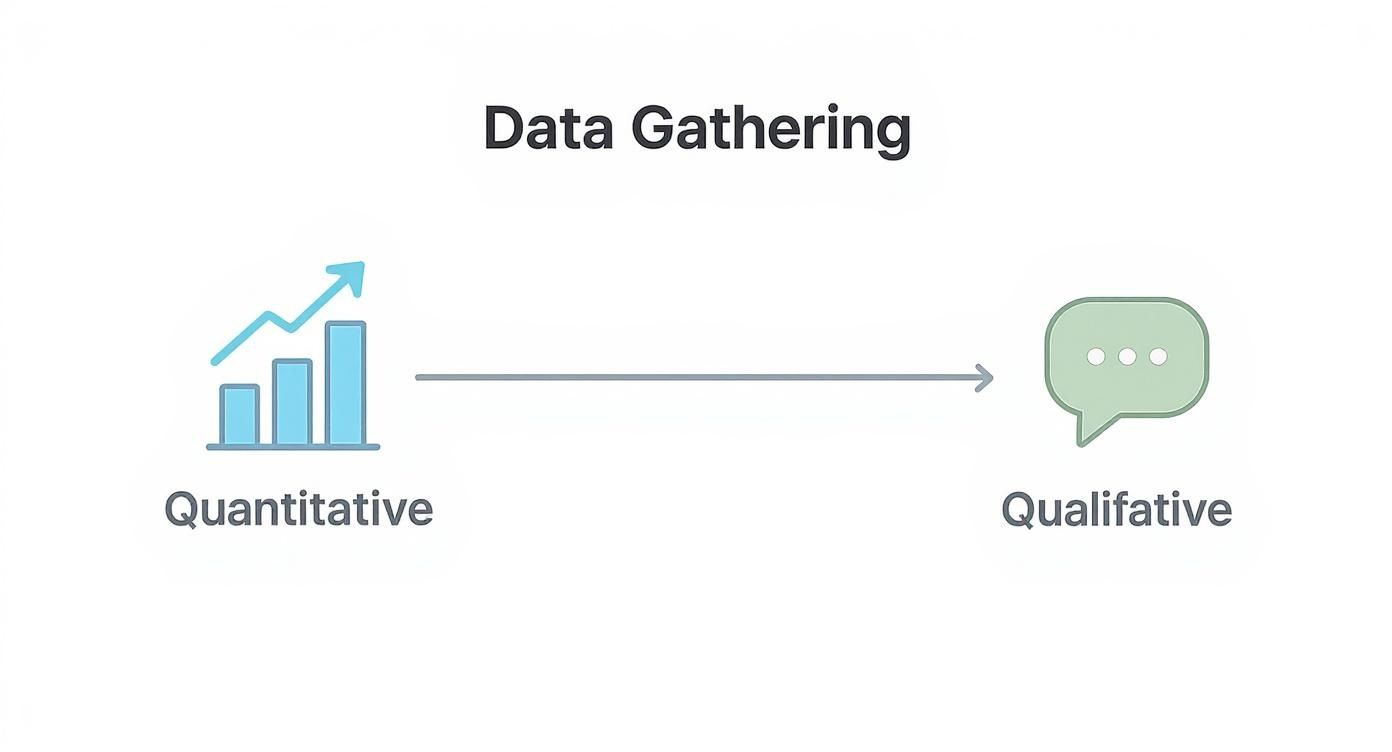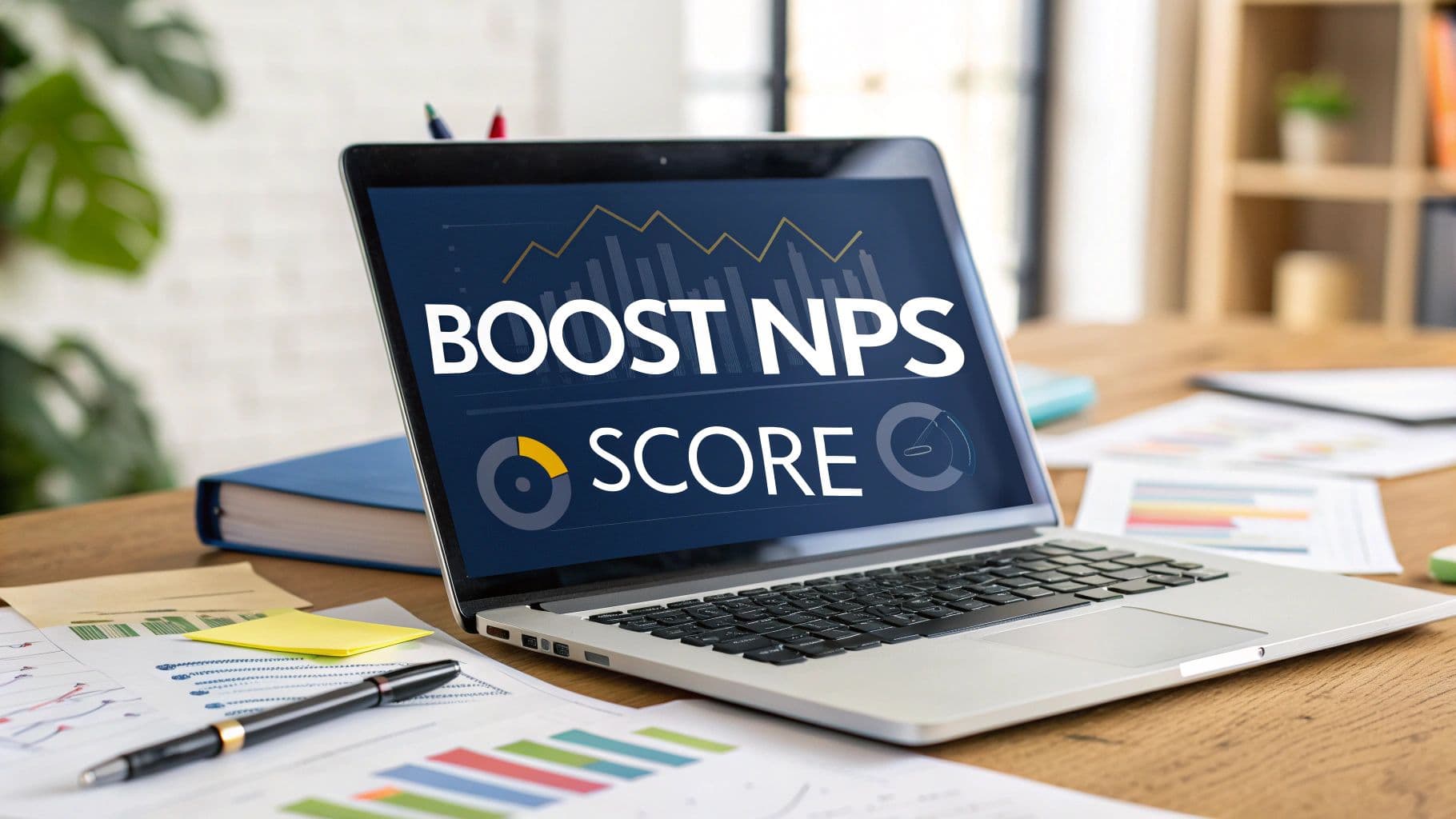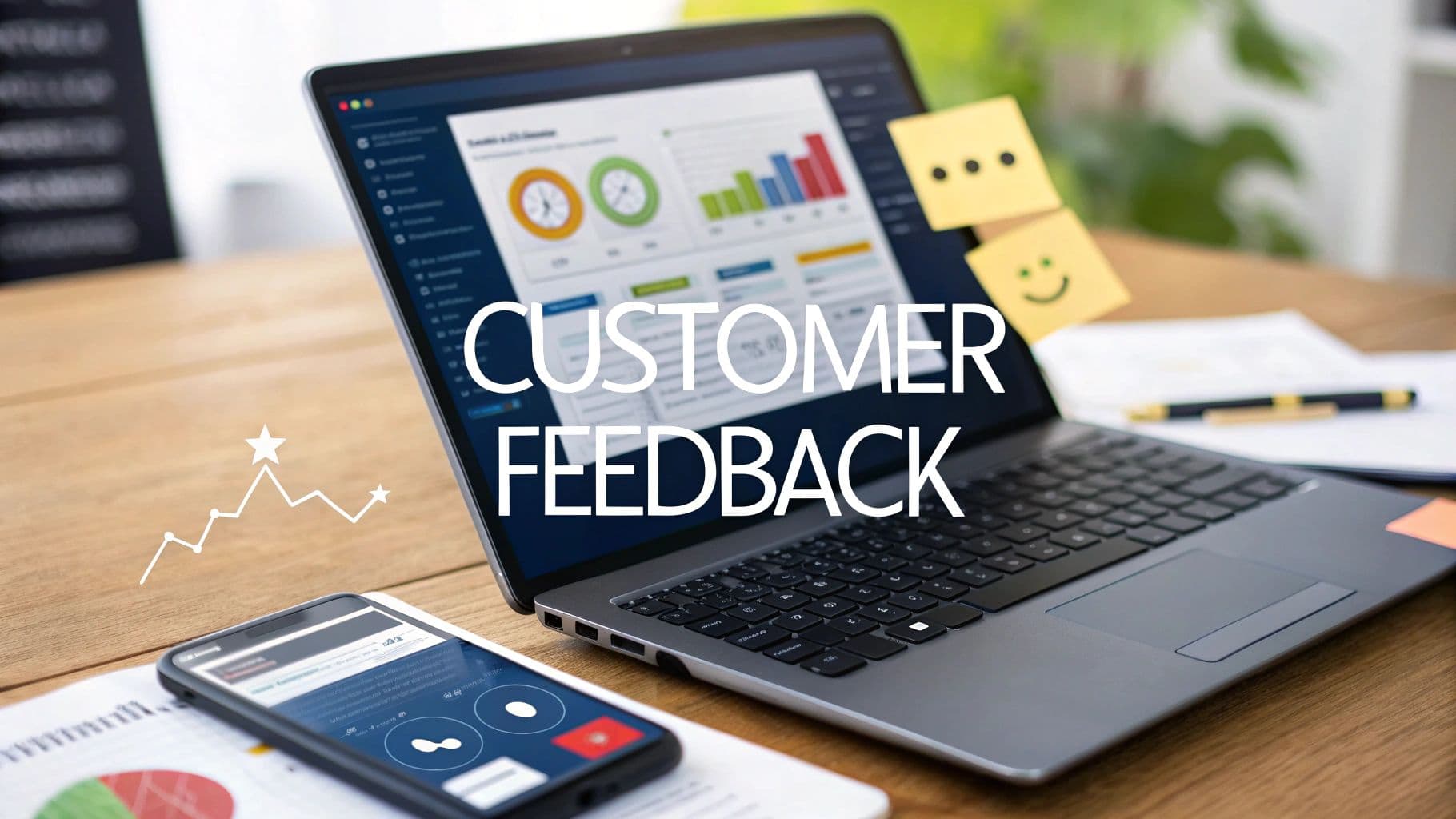Using Customer Behavior Insights for Growth
Unlock business growth by leveraging customer behavior insights. This guide explains how to gather, analyze, and apply data to improve marketing and retention.

Customer behavior insights are the stories your data is trying to tell you—the critical narratives that explain why people do what they do. Think of it as moving beyond simple numbers and spreadsheets. These insights uncover the real human motivations, frustrations, and desires behind every click, purchase, and interaction.
Ultimately, this understanding turns raw information into a clear, strategic roadmap for growth.
What Are Customer Behavior Insights?

Let's put on our detective hats for a moment. All across your business, you have scattered clues: website clicks, purchase histories, support tickets, and the time someone spends on a page. These clues tell you what happened. They're the facts of the case.
Customer behavior insights, on the other hand, are the conclusions you draw after connecting all those clues. It’s the story that finally reveals the "why."
For example, your data might scream that 70% of users abandon their shopping carts right at the shipping page. That’s a critical "what."
The Bridge Between Data and Strategy
The real insight, however, is figuring out why they’re leaving. Are they getting sticker shock from surprise shipping costs? Or is the address form a nightmare to use on a phone? This deeper understanding is the essential bridge connecting raw data to a smart business strategy.
Instead of just guessing, you can move forward with confidence. Unlocking these insights allows you to:
- Anticipate Needs: You can start solving problems your customers haven't even complained about yet.
- Improve Experiences: Find and eliminate the little friction points that cause frustration and drive people away.
- Build Better Products: Focus your team’s energy on features that truly align with what users are trying to accomplish.
It's easy to get lost in the numbers, but a simple table can help clarify the difference between just having data and truly understanding it.
The Difference Between Data and Insights
| Data Point (The 'What') | Customer Behavior Insight (The 'Why') | Resulting Business Action |
|---|---|---|
| 35% of new users drop off after the first login. | Users feel overwhelmed by the dashboard's complexity and don't know where to start. | Create a simplified, guided onboarding tutorial that highlights key features one by one. |
| The "Compare Products" feature is the least-clicked button on the page. | Customers don't notice the feature because its placement and design lack visibility. | Redesign the button with a contrasting color and move it to a more prominent location. |
| Mobile users spend 50% less time on site than desktop users. | The mobile checkout process requires too many steps and is poorly optimized for small screens. | Implement a one-click payment option and streamline the mobile checkout flow. |
Seeing the pattern? Each insight explains a human problem that the data merely pointed to, which then leads directly to a practical, value-adding solution.
Ultimately, customer behavior insights change how you view your audience. You stop seeing them as entries in a database and start understanding them as people with specific goals and challenges. This shift is the key to creating products they not only use but love.
To dig deeper into the mechanics, you can explore our guide on what is behavioral analytics, which details how to track and interpret these actions. This knowledge helps you build a business that not only brings customers in but also earns their long-term loyalty by meeting their unspoken needs.
Why Insights Are Your Strategic Advantage
https://www.youtube.com/embed/vKSvLjIaxQQ
Treating customer behavior insights as just another marketing metric is like owning a race car but only ever driving it to the grocery store. It's a huge missed opportunity. In reality, these insights are a competitive superpower that should shape every corner of your business, from your product roadmap to your customer support scripts.
When you finally get to the "why" behind what your customers do, you can stop guessing. Instead of building features you think people want, you can start creating solutions to problems they’re actually having. That one change transforms your entire development cycle from a shot in the dark into a smart investment.
Fueling Smarter Product Development
Think of these insights as a direct line to your user's unspoken needs. Let's say your analytics show people constantly clicking on a part of your dashboard that isn't actually a button. That's not just a random data point; it’s a bright, flashing sign of what they expect to happen. They want something to be there, and it isn't.
Putting this kind of insight to work lets you:
- Prioritize with Confidence: You can put your development resources into features that have a clear, user-driven demand behind them.
- Reduce Wasted Effort: No more spending months building out a complicated feature that solves a problem nobody has.
- Innovate Proactively: You can spot emerging needs long before your competitors do, making your product feel essential.
This approach ensures your product evolves right alongside your customers. It becomes stickier, more intuitive, and ultimately, something they can't imagine working without.
Enhancing Customer Experience and Retention
A great customer experience isn't just a nice-to-have anymore; it's what people expect. The quality of your service has a direct line to loyalty and revenue, and a bad experience can cause immediate damage.
Consider this: 99% of consumers say customer service is a key factor when picking a brand, and a whopping 74% call it essential. The stakes are incredibly high, especially when you learn that 70% of customers will walk away after just two negative interactions. You can dig into more statistics about the rising importance of customer experience to see just how critical this is.
By analyzing customer behavior, you can pinpoint the exact moments of friction. Maybe users are getting tripped up on your billing page, or a confusing setting is causing a flood of support tickets. Fixing these specific pain points does more than just solve an immediate problem.
It shows your customers you’re listening. That simple act builds trust and can turn a casual user into a passionate advocate for your brand. By smoothing out these little frustrations one by one, you create an experience that just works, giving people every reason to stick around and turning retention into a reliable engine for growth.
How to Gather Your Customer Clues
To find truly powerful customer insights, you have to start by gathering the right clues. I like to think of this process in two parts: one side tells you what your customers are doing, and the other explains why they're doing it. The real magic happens when you blend these two types of information to build a complete picture.
First, you need the hard numbers. This is your quantitative data—the measurable actions that show you exactly what’s happening on your website, in your app, or at the checkout counter. Think of this as the objective evidence in your investigation.
Common sources for this data include:
- Website Analytics: Tools like Google Analytics are indispensable. They show you page views, bounce rates, and the paths people take, quickly revealing what’s popular and where they’re getting stuck.
- Transaction Logs: This is a direct look at purchasing habits. It tracks what people buy, how much they spend, and how often they return, pointing you to your most popular products and loyal customers.
- Product Usage Metrics: For any software or app, you need to know which features people are actually using. Tracking feature adoption, click patterns, and session times tells you how users are engaging with what you’ve built.
Uncovering the "Why" with Qualitative Data
While numbers tell you what’s happening, they rarely explain the motivation behind it. That's where qualitative data comes in. It breathes life into the statistics by revealing customer feelings, opinions, and frustrations—the human context that numbers alone will never give you.
Getting this context requires you to have those essential conversations. Whether you're sending out a survey or sitting down for an interview, learning how to ask better questions is the key to collecting honest, valuable feedback. The quality of your insights is directly tied to the quality of your questions.
Here are some of the most effective ways to gather qualitative data:
- Surveys & Feedback Forms: These are perfect for capturing sentiment in the moment—like right after a purchase or a support chat. A simple, well-timed survey can tell you exactly why someone almost abandoned their shopping cart.
- User Interviews: There’s no substitute for a direct, one-on-one conversation. It's your chance to ask follow-up questions and dig into the nuances of someone's experience in a way that no automated tool can.
- Social Media Listening: Your customers are already talking about you. Monitoring brand mentions, comments, and discussions on social media gives you an unfiltered look at what people really think about your brand and your competitors.
- Support Tickets & Chat Logs: Your customer service channels are a goldmine of insights. These conversations are filled with recurring pain points and common questions that point directly to friction in the customer journey.
To help put this into perspective, here's a quick breakdown of the most common methods for collecting both types of data.
Key Data Collection Methods
| Method | Type (Qualitative/Quantitative) | Best For Understanding | Example Tool |
|---|---|---|---|
| Web Analytics | Quantitative | User navigation, traffic sources, and conversion funnels | Google Analytics |
| Surveys | Both | Customer satisfaction (CSAT), sentiment, and specific feedback | SurveyMonkey |
| User Interviews | Qualitative | Deep motivations, user needs, and usability issues | UserTesting |
| Transaction Data | Quantitative | Purchase history, frequency, and average order value (AOV) | Shopify Analytics |
| Social Listening | Qualitative | Brand perception, competitor sentiment, and emerging trends | Brand24 |
| Support Tickets | Qualitative | Common problems, product friction, and feature requests | Zendesk |
Ultimately, a strong strategy uses both. Your quantitative data might tell you that 70% of users drop off at a certain step in your sign-up process. That’s the "what." It’s your qualitative data from user interviews and feedback forms that will tell you why—maybe the form is confusing or asks for too much information.
When you bring all this feedback together, it can feel like a lot to sort through. That's why many teams rely on specialized customer feedback analysis tools to help consolidate and make sense of it all. By combining these different sources, you can stop guessing and start building a clear path to a better customer experience.
Connecting the Dots to Find the Story
Collecting customer data is a lot like gathering thousands of individual stars. By themselves, they’re just scattered points of light. The real magic happens when you connect those stars to reveal a constellation—a clear picture that tells a story. This is the crucial step of analysis, where raw information becomes powerful customer behavior insights.
Without analysis, your data is just noise. It’s the process of finding patterns that turns messy spreadsheets into a coherent narrative that can actually guide your business strategy. Think of yourself as a storyteller, using data to explain why your customers do what they do.
To get a handle on this, delving into the specifics of customer feedback analysis is a great starting point for illuminating their needs and connecting the dots.
Uncovering Hidden Patterns
The whole point of analysis is to move beyond the obvious. Sure, a simple chart might show a dip in sales, but a deeper dive could reveal it's directly linked to a recent app update that introduced a nasty bug for Android users. This is where modern tools, especially those powered by AI, really shine—they can spot connections that even a seasoned analyst might miss.
Here are a few of the go-to techniques for finding the story in your data:
- Customer Segmentation: This is all about grouping customers based on shared traits like their purchase history, demographics, or how often they log in. It helps you realize you don't just have one audience; you have several distinct groups with their own unique needs.
- Churn Prediction: By digging into the behavior of customers who've already left, you can identify the warning signs among your current users. This gives you a chance to step in and fix things before they decide to cancel their subscription.
- Lifetime Value (LTV) Analysis: This technique helps you forecast the total revenue you can expect from a single customer over their entire relationship with you. It’s a game-changer for highlighting your most valuable customer segments and showing you exactly where to focus your marketing and retention efforts.
The infographic below breaks down the two core types of data that fuel this entire analysis process.

As you can see, you need both quantitative data (the "what") and qualitative data (the "why") to get the complete picture. One without the other leaves you guessing.
From Analysis to Actionable Strategy
The story you uncover has to lead somewhere—to a clear business action. This is becoming non-negotiable as customers increasingly expect and demand more relevant, personalized experiences.
Marketing strategies are already shifting to meet these new expectations. A recent Deloitte outlook for 2025 found that nearly 70% of executives at consumer goods companies are planning to increase their marketing and advertising budgets. This spending surge isn't just about making more noise; it's a direct response to a fragmented consumer base that requires highly personalized messaging to cut through.
Ultimately, connecting the dots is about turning your data into a visual narrative. Understanding the best practices for data visualization is key here, as it helps you present your findings in a way that is clear, compelling, and actually drives decisive action across your organization.
Putting Customer Insights Into Action

Theories and number-crunching are great, but the real magic of customer behavior insights happens when you actually do something with them. The best brands aren't just sitting on piles of data; they’re using it to make smart moves that grow their business.
Looking at how others have succeeded gives us a fantastic roadmap. Let's walk through a couple of real-world scenarios where a simple observation about customer behavior led to huge wins.
From Cart Abandonment to Increased Sales
An e-commerce brand was staring at a classic problem: tons of shoppers were ditching their carts right at the last step. The data told them what was happening, but the real "aha!" moment came when they started watching session replays of those failed checkouts.
It turned out that mobile users were getting tripped up by a clunky, multi-page address form. It was a pain to use on a small screen, and that friction was killing conversions.
- The Insight: The mobile checkout form was a nightmare, causing would-be buyers to give up in frustration.
- The Action: They completely streamlined the process, cutting down the number of fields and adding a one-click payment option.
- The Outcome: This one fix resulted in a 22% drop in cart abandonment and a major boost in mobile revenue.
It’s a perfect example of how one sharp insight can plug a massive leak in your sales funnel.
This kind of focus on the user experience is non-negotiable now. The shift to online shopping is massive. A recent McKinsey survey revealed that over 90% of consumers in the U.S. and China bought from an online-only store in the last month alone. You can read the full analysis of consumer trends to grasp the full scale of this change.
Slashing Churn with Personalized Onboarding
Here's another one: a SaaS company was bleeding new customers. Their 30-day churn rate was alarmingly high. Digging into their product analytics, they found a gem: users who tried the "project template" feature in their first week were 80% more likely to stick around.
The problem? Fewer than 15% of new users ever found this critical feature. The generic, one-size-fits-all onboarding tour just wasn't cutting it.
- The Insight: Getting users to engage with project templates early on was the key to long-term retention.
- The Action: The team redesigned their onboarding to actively steer new sign-ups toward creating their first template, even personalizing the tutorial based on their role.
- The Outcome: They slashed their 30-day churn by an incredible 40%, which had a massive positive impact on customer lifetime value.
As you can see, these insights aren't just interesting factoids for a report. They are practical, actionable clues that show you exactly where to focus your efforts to build a stronger, more profitable business.
Frequently Asked Questions
Digging into customer behavior can bring up a lot of questions. It's totally normal. Whether you're just getting your business off the ground or you're part of an established team looking to sharpen your approach, getting the basics right is always the best place to start.
We've put together some straightforward answers to the questions we hear most often. Think of this as your foundation for understanding what really makes your customers tick.
Whats The Difference Between Customer Insights And Market Research
This is a great question, and the answer really gets to the core of why this stuff is so powerful. While they're definitely related, they approach customer understanding from two very different angles.
Market research is all about what people say they do. It’s the big-picture view, using tools like focus groups, industry-wide surveys, and demographic reports. It gives you a general sense of market trends, popular opinions, and broad perceptions. Think of it as a wide-angle lens showing you the whole landscape.
Customer behavior insights, on the other hand, focus on what people actually do. You're looking at real actions—clicks, purchases, how they move through your website—to figure out the "why" behind their choices. It’s like using a zoom lens to see the specific, authentic journey your customers are taking.
Market research might tell you that 65% of consumers claim they want a simple checkout process. But customer behavior insights will show you that your users are dropping off because your checkout has one too many steps.
Basically, market research gives you the context, while customer insights give you the proof.
How Can Small Businesses Gather Insights On A Budget
You absolutely don't need a huge budget to start learning from your customers. In fact, some of the most powerful tools out there are either free or have very affordable plans, so any business can start collecting clues without breaking the bank.
Here are a few practical ways to get going:
- Fire Up Free Analytics: Tools like Google Analytics are completely free and packed with useful quantitative data. You can see how users get to your site, which pages they love, and where they tend to leave.
- Use Simple Surveys: You can get a lot done with the free versions of tools like SurveyMonkey or even a basic Google Form. A great trick is to put a short feedback survey on your "thank you" page right after a purchase to catch customers when their experience is fresh.
- Dig into Your Existing Channels: Your customer support inbox and social media comments are absolute goldmines. Just reading through these conversations can show you recurring problems and popular feature requests, and it costs you nothing but time.
The trick is to start small. Just pick one or two key questions you want to answer and go from there.
Is It Ethical To Track Customer Behavior
This is probably the most important question of all. The short answer is yes, it is ethical—but only if you do it responsibly, transparently, and with your customer's best interests at the forefront. Being ethical with data isn't just about following the rules; it's about building trust.
Responsible data handling really comes down to a few key ideas:
- Transparency: Be clear and upfront with people about what you’re collecting and why. Your privacy policy shouldn't be hidden away or filled with legal jargon nobody can understand.
- Consent: Always get clear permission before collecting personal data. This is the whole point of regulations like the General Data Protection Regulation (GDPR) in Europe.
- Security: If you collect data, you have a duty to protect it. That means having strong security measures in place to prevent breaches and keep your customers' information safe.
At the end of the day, the goal is to use customer behavior insights to make their experience better, not to exploit them. When you get this right, everybody wins: your customers get a product that truly serves them, and you earn their loyalty.
Ready to turn customer feedback into your biggest growth driver? SigOS uses AI to analyze support tickets, sales calls, and usage data, pinpointing the exact issues costing you money and the features that will unlock major revenue. Stop guessing and start building what matters.


